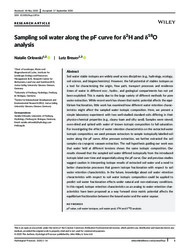Sampling soil water along the pF curve for δ2H and δ18O analysis
DOI: https://doi.org/10.1002/hyp.13916
Persistent URL: http://resolver.sub.uni-goettingen.de/purl?gldocs-11858/9488
Persistent URL: http://resolver.sub.uni-goettingen.de/purl?gldocs-11858/9488
Orlowski, Natalie; Breuer, Lutz, 2020: Sampling soil water along the pF curve for δ2H and δ18O analysis. In: Hydrological Processes, DOI: 10.1002/hyp.13916.
 |
Dokument öffnen: |
Soil water stable isotopes are widely used across disciplines (e.g., hydrology, ecology, soil science, and biogeochemistry). However, the full potential of stables isotopes as a tool for characterizing the origin, flow path, transport processes and residence times of water in different eco-, hydro-, and geological compartments has not yet been exploited. This is mainly due to the large variety of different methods for pore water extraction. While recent work has shown that matric potential affects the equilibrium fractionation, little work has examined how different water retention characteristics might affect the sampled water isotopic composition. Here, we present a simple laboratory experiment with two well-studied standard soils differing in their physico-chemical properties (e.g., clayey loam and silty sand). Samples were sieved, oven-dried and spiked with water of known isotopic composition to full saturation. For investigating the effect of water retention characteristics on the extracted water isotopic composition, we used pressure extractors to sample isotopically labelled soil water along the pF curve. After pressure extraction, we further extracted the soil samples via cryogenic vacuum extraction. The null hypothesis guiding our work was that water held at different tensions shows the same isotopic composition. Our results showed that the sampled soil water differed isotopically from the introduced isotopic label over time and sequentially along the pF curve. Our and previous studies suggest caution in interpreting isotope results of extracted soil water and a need to better characterize processes that govern isotope fractionation with respect to soil water retention characteristics. In the future, knowledge about soil water retention characteristics with respect to soil water isotopic composition could be applied to predict soil water fractionation effects under natural and non-stationary conditions. In this regard, isotope retention characteristics as an analog to water retention characteristics have been proposed as a way forward since matric potential affects the equilibrium fractionation between the bound water and the water vapour.
Statistik:
ZugriffsstatistikSammlung:
This is an open access article under the terms of the Creative Commons Attribution-NonCommercial License, which permits use, distribution and reproduction in any medium, provided the original work is properly cited and is not used for commercial purposes.

